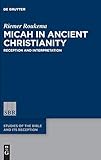Micah in Ancient Christianity : Reception and Interpretation / Riemer Roukema.
Material type: TextSeries: Studies of the Bible and Its Reception (SBR) ; 15Publisher: Berlin ; Boston : De Gruyter, [2019]Copyright date: ©2019Description: 1 online resource (XV, 283 p.)Content type:
TextSeries: Studies of the Bible and Its Reception (SBR) ; 15Publisher: Berlin ; Boston : De Gruyter, [2019]Copyright date: ©2019Description: 1 online resource (XV, 283 p.)Content type: - 9783110663402
- 9783110663914
- 9783110666021
- 230
- BS1615.55
- online - DeGruyter
- Issued also in print.
| Item type | Current library | Call number | URL | Status | Notes | Barcode | |
|---|---|---|---|---|---|---|---|
 eBook
eBook
|
Biblioteca "Angelicum" Pont. Univ. S.Tommaso d'Aquino Nuvola online | online - DeGruyter (Browse shelf(Opens below)) | Online access | Not for loan (Accesso limitato) | Accesso per gli utenti autorizzati / Access for authorized users | (dgr)9783110666021 |
Browsing Biblioteca "Angelicum" Pont. Univ. S.Tommaso d'Aquino shelves, Shelving location: Nuvola online Close shelf browser (Hides shelf browser)
Frontmatter -- Preface -- Contents -- Abbreviations -- I. Introduction -- II. Micah in the New Testament -- III. Church Fathers: Introduction -- IV. Heterodox views -- V. Patristic interpretation of Micah -- VI. Liturgical use of Micah -- VII. Jesus’ quotation of Mic 1:7 in b‘Abodah Zarah -- Epilogue -- Bibliography -- Index of Subjects
restricted access online access with authorization star
http://purl.org/coar/access_right/c_16ec
What happened when the writing of the Old Testament prophet Micah from the 8th century BCE was read and interpreted by Christians in the 1st to 5th century BCE? This research meticulously describes data from patristic commentaries and other ancient Christian works in Greek and Latin, as well as the remains of Gnostic receptions of Micah, and it analyses the interpretative strategies that were adopted. Attention is paid to the partial retrieval of Origen’s Commentary on Micah, which is lost nowadays, but was used by later Christian authors, especially Jerome. This work includes the ancient delimitation of the Septuagint version and patristic observations on the meaning of particular terms. Other aspects are the liturgical readings from Micah’s book up to the Middle Ages, its use in Christ’s complaints about Israel on Good Friday (the Improperia), and a rabbinic tradition about Jesus "ing Micah. It is noted whenever patristic authors implicitly use or explicitly "e Jewish interpretations, many of which are supplied with parallels in contemporaneous or medieval Jewish works. This first comprehensive survey of the ancient Christian reception and interpretation of Micah is a valuable tool for Biblical scholars and historians.
Issued also in print.
Mode of access: Internet via World Wide Web.
In English.
Description based on online resource; title from PDF title page (publisher's Web site, viewed 28. Feb 2023)









